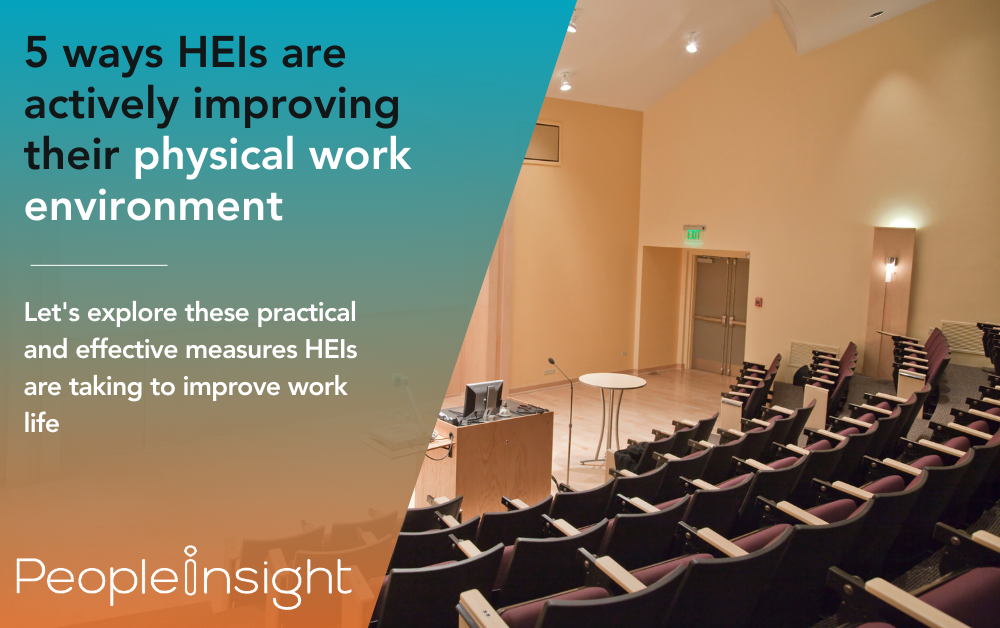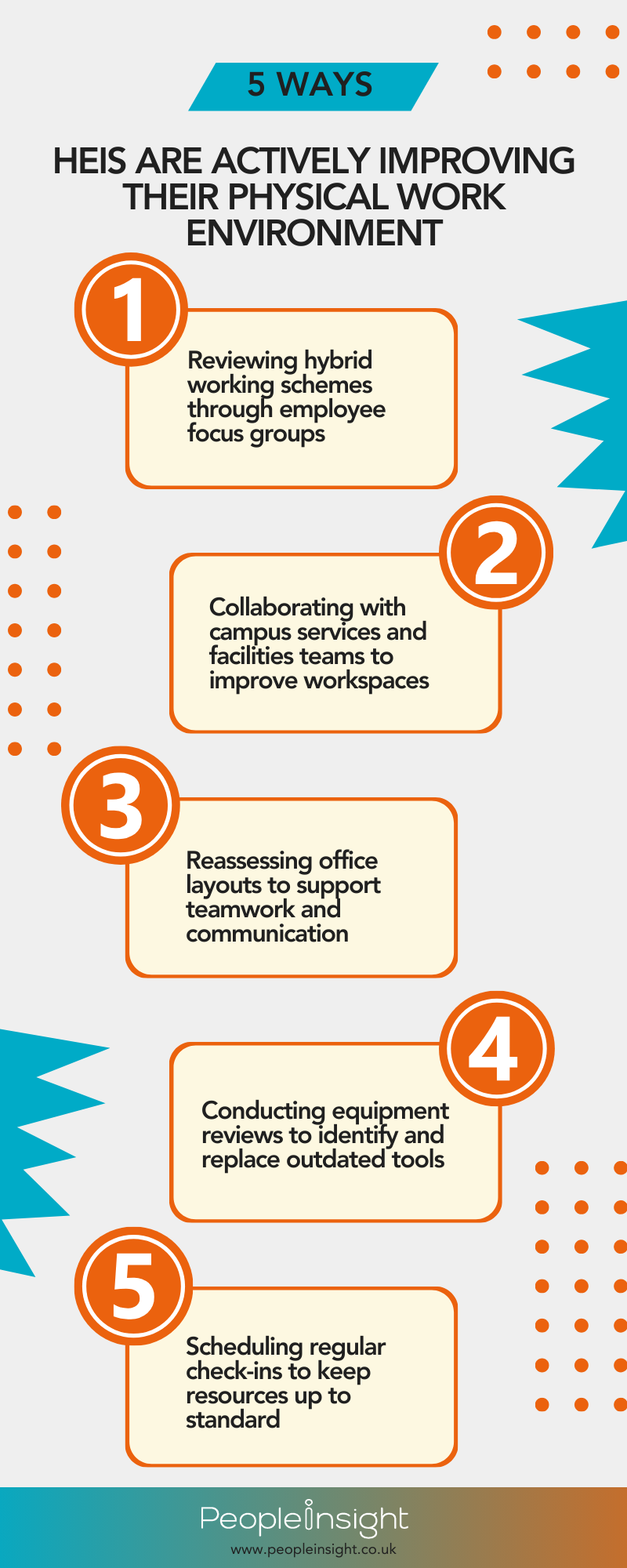
The higher education sector is an inspiring place to work, filled with opportunities and rewarding projects that drive both personal and professional growth. It’s no surprise that so many people love working in higher education.
However, while there are many perks to working in higher education, like any sector, it has its areas for improvement. Each institution should strive to understand where these improvements are needed, actively listening to its employees and acting on their feedback. Based on responses from higher education staff surveys, many institutions have implemented strategies to improve one of the most discussed areas — the physical work environment.
Thanks to our comprehensive benchmark data, we know that 63% of higher education employees are content with their physical work environment, which is lower than the all-sector average of 75%. Interestingly, satisfaction levels vary within the sector. Professional services staff reported a higher satisfaction rate of 67%, while academics showed a lower rate at 56%.What’s more, 64% of higher education employees felt they had the necessary equipment and resources for their work — again below the all-sector benchmark of 72%. We also know, through previous research and studies carried out by other sources, that employee perception of their physical work environment has a huge impact on psychological wellbeing.
These insights show that there is certainly room for improvement in creating a more supportive, well-equipped physical work environment for all employees.
We’re lucky enough to work with over 75 higher education institutions (HEIs). Some of these HEIs have shared the tried-and-tested approaches they’ve implemented to improve the physical work environment for their staff.
Related: How HEIs are creating a sense of purpose at work

Many HEIs have taken an innovative approach to hybrid working, recognising that a flexible work setup can impact the physical work environment in a significant way. Institutions that implemented hybrid working models during the pandemic saw the need to reassess their strategies in light of changing demands. By organising focus groups, they opened up discussions directly with employees to understand how their physical work environment — whether on-campus or remote — could be improved.
These focus groups provided employees with a platform to share experiences about how their physical work environment could better support them. Topics such as workstation ergonomics, accessibility to resources both on-campus and remotely, and the ease of commuting were raised. This inclusive approach not only generated valuable insights but also created a sense of involvement, empowering employees to take part in shaping their physical workspace for the better.
The physical work environment extends beyond office walls, encompassing the entire campus experience. To improve employee sentiment in this area, HEIs have worked closely with campus services, facilities and estates teams to enhance both indoor and outdoor spaces. These collaborations have aimed to create more welcoming and functional spaces for all staff, including better indoor air quality, optimised lighting and more comfortable communal areas.
As an example, some HEIs have invested in quiet zones, wellness rooms and green spaces to offer employees a break from traditional office settings. These areas provide staff with places to recharge and engage in informal interactions, which can improve both mental well-being and workplace culture. Small changes like ergonomic furniture, improved cafeteria options and eco-friendly practices in the workplace have also played a role in shaping a better physical work environment.
The office layout plays a considerable role in how effectively teams work together. Recognising this, some HEIs have redesigned their office spaces to support larger teams and facilitate seamless communication. In higher education, where both academic and administrative tasks often require collaboration, a well-organised physical work environment can make a notable difference in productivity.
Office layout redesigns have involved moving away from traditional, isolated cubicles toward more open-plan spaces. These new layouts allow teams to communicate more freely and work together more cohesively, boosting morale and promoting a more interactive workplace. For larger teams, hot-desking setups or team zones with communal work areas have been introduced. These changes help reduce bottlenecks in communication, making daily operations smoother and creating a more dynamic physical work environment.
Related: How HEIs are improving communication at work
One frequent concern raised by HEI staff is the availability and condition of work tools and equipment. Having the right resources can make all the difference to productivity and without them, employees can feel frustrated, not to mention undervalued. HEIs have responded to this by conducting regular equipment reviews with each team, focusing on identifying any tools or technologies that may need upgrading.
These reviews often involve discussions with staff about their specific needs, whether it’s up-to-date computer systems, software or laboratory equipment. By replacing outdated tools, institutions not only make tasks easier for staff but also show that they are committed to maintaining a functional and supportive physical work environment. This focus on modernising equipment is particularly beneficial to academic staff, who were shown to have lower satisfaction rates with resources compared to their counterparts in professional services.
Maintaining a high-quality physical work environment is an ongoing process. Understanding this, many HEIs have scheduled regular check-ins with teams to make sure resources remain up to standard and that employees have what they need. These check-ins are usually led by line managers or department heads and cover topics like resource quality, access to necessary materials, and workspace conditions.
Regular check-ins help prevent small issues from becoming larger frustrations and demonstrate a commitment to continuously improving the physical work environment. This proactive approach also enables HEIs to address any potential problems before they impact employees’ ability to work effectively. For instance, ensuring air-conditioning systems are functioning, providing adequate lighting or addressing temperature control issues can make a significant difference in comfort and, therefore, productivity. These regular check-ins play an important role in aligning physical resources with employees’ evolving needs.
Improving the physical work environment is a huge part of creating a supportive and productive workplace in higher education. In taking the measures mentioned above, HEIs are making meaningful strides to boost employee engagement and improve the employee experience. The higher education sector may face challenges, but the efforts institutions put into maintaining a positive and supportive physical work environment prove that progress is always possible. Through these measures, HEIs not only demonstrate their commitment to staff but also create an environment where employees can thrive.
To find out where your institution can improve its employee experience, get in touch today to discuss your employee listening strategy. We work with HEIs across the UK and beyond, we understand the sector and we know what it takes to make meaningful change.
